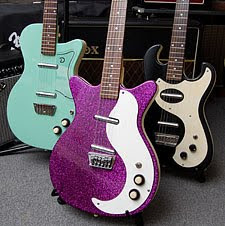If you spend anytime at all listening to Telecaster players, you're likely to hear some pretty crazy string bending going on. Players like Will Ray, Forrest Lee, Jr., Jerry Donahue and Jim Campilongo just to name a few. Usually this is standard stuff for country players. You can either use your fingers to do the bending; even behind the nut bends, or use a crazy device featured in this video: Fender Classic Vibe with G Bender.
This is once again, another headless demo.
And also, as a reminder, I'm not a country player, but I play one on the internet.
Saturday, April 23, 2011
Thursday, April 7, 2011
Danelectro guitars - Masonite miracles
 What can one say about Masonite? First off, it was invented in Mississippi by William Mason in 1924, and unlike other kinds of particle board, it's made entirely of natural ingredients (basically wood chips). If you were to grind it up, pour it into a bowl and add a little milk, it might be as good a breakfast cereal as anything you can buy in your local health food store. I don't suggest you try this at home, however.
What can one say about Masonite? First off, it was invented in Mississippi by William Mason in 1924, and unlike other kinds of particle board, it's made entirely of natural ingredients (basically wood chips). If you were to grind it up, pour it into a bowl and add a little milk, it might be as good a breakfast cereal as anything you can buy in your local health food store. I don't suggest you try this at home, however.The other thing about Masonite, is that most Danelectro guitars use it for their construction. Other materials used for the Danelectro include vinyl as well as that rare, exotic wood found in the outback regions of Home Depot, plywood.
First built in 1954, Danelectros originally cost $69 and could often be purchased at any Sears and Roebuck under the Silvertone brand name.
I own three Danelectros, all reissues, two of which cost less than $240. New, they are around $399 for a six-string and $449 for a 12-string (if you can find one). Also available are baritone and bass models.
When you buy a $3000 Les Paul with a beautifully carved striped maple top, Brazilian mahogany body and neck and rosewood fingerboard, you expect to pay big money. You don't have to worry about that with a Danelectro. Just thank William H. Mason for inventing Masonite which helped Nathan Daniel invent this inexpensive, great sounding guitar.
My '63 Reissue Danelectro (YouTube)
My '56 Reissue Danelectro (YouTube)
Danelectro celebs
www.danelectro.com
www.danguitars.com
Monday, April 4, 2011
Building a Partscaster
 I've been wanting to build an early-50's Telecaster replica for quite a while, you know, since dinosaurs roamed the earth. I even had an unfinished body sitting around in my basement for a couple years, then I decided to work out (rim shot please). No really, I had a Tele body waiting for paint and waiting for me to take the plunge by getting off the couch.
I've been wanting to build an early-50's Telecaster replica for quite a while, you know, since dinosaurs roamed the earth. I even had an unfinished body sitting around in my basement for a couple years, then I decided to work out (rim shot please). No really, I had a Tele body waiting for paint and waiting for me to take the plunge by getting off the couch.After sealing, sanding and painting in the warmer months last year (yeah, I know, I'm really slow about these things), I finally began amassing and adding the hardware needed. My finishing job however, left a lot to be desired. The surface of the body, in places, has the texture of Tommy Lee Jones' face. After painting it, I could really see the spots that could have used more sanding before I had painted. From now on I'm calling it "reliced," which is guitar-speak for antiqued.
Initially, I decided to use some of the hardware and neck from my 2000 American Telecaster, mostly to see if the routs and the body were correct. Turns out they were a little off, but not so much as to make the body unusable. I forged ahead into unknown territory.
Once I got the strings on, and did a few minor adjustments, I had to admit, and my wife can verify this, it was the worst playing guitar I'd ever owned. Really.
Ok, with a few more neck and bridge adjustments, it started to play a bit better. Then came the real test. Plugging it in.
My 8-year old son had been making jokes, imagining that when I did plug it in, all we would hear was something akin to an old man trying to clear his clogged nasal passages on a humid July evening. But miracles do occur, and when we fired up the Super Champ, we actually heard a guitar; no loud humming, buzzing or rude noises anyone's aunt would be offended by. It sounded like a Tele, and a good one at that.
On a more technical note, I have an SD Broadcaster pickup in the bridge position and a Custom Shop Texas Special in the neck position. Next step is to find a period correct neck and some domed knobs and I'll be good to go!
Subscribe to:
Posts (Atom)
